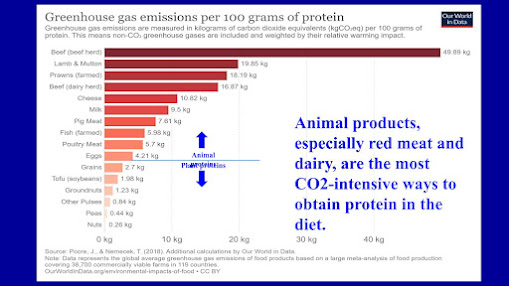by Eric Diekhans
It seems like everything about America is big, whether it’s our
landscapes, our superhero movies, our McMansions, or our SUVs. But that
abundance results in a disproportionate impact on global warming. Each year,
Americans are responsible for 19 tons of CO2 emissions per capita, as compared
to seven tons for Europe, two tons for South Asia, and one ton for Sub-Saharan
Africa.
Fifteen percent of those emissions comes from food and food
waste. It’s not the largest source of our carbon footprint but it still has a
substantial impact on climate change. Making different choices about food can
make a real difference in avoiding the worst impacts of global warming.
As a member of Montclair Presbyterian Church (MPC) in Oakland,
CA, Suzanne Jones helps lead the Earth Care Committee’s Climate and Food Team and
recently co-authored MPC’s new cookbook, Climate Friendly Cooking—105 Recipes to
Help Save the Planet. During her presentation
at PEC’s conference, Suzanne admitted that changing our diets isn’t easy. Food
has important connections to our emotions, our habits, and our identities.
Think of Thai beef noodles, British steak and kidney pudding, or Cuban boliche.
“It can be difficult and even painful to change such deeply held
practices,” said Suzanne, but we can harmonize our food-related needs with
leaving behind a livable planet and still be healthy and well-fed.”
Suzanne said that “the dominant factor that determines our
dietary greenhouse gas emissions is what we choose to eat for protein.”
Thirty-one percent of agricultural emissions comes from livestock
and fisheries. Most adults need 50-175 grams of protein per day. Eating 100
grams of beef protein emits 49.89 kg of carbon. Getting the same amount from
nuts emits about half that amount.
But you don’t have to completely give up meat to make a positive
environmental impact. Ruminants do the most damage to our environment. These
are animals like cattle, bison, and sheep that chew the cud regurgitated from
their second stomach, or rumen.
This causes them to exhale methane, which is 80 times stronger than CO2 as a
greenhouse gas. Ruminant waste also emits CH4 and nitrous oxide n20, which are
300 times more potent as greenhouse gases than CO2.
“Cutting out just red meat and dairy products results in
emissions comparable to pescatarians (who eat fish but not meat) and
lacto-ovo-vegetarians (who eat plants, eggs, and dairy products),” says
Suzanne.
If you don’t want to become a full-time vegetarian or
pescatarian, Suzanne suggests saving beef for special occasions like Christmas
dinner, and getting most of your protein from pork, chicken, and plants.
Fish is also another good source of protein, but choosing the
right seafood is complicated. Wild-caught fish tend to be better for the
environment than farm-raised, though new methods of raising fish on land are
changing that calculation. Plus, ocean ecosystems are very stressed due to
overfishing, pollution, and acidification from CO2 emissions.
Crab, lobster, and some oysters and prawns are very high in CO2
emissions because boats must go out and check traps often.
You can learn about the best options for choosing seafood using
the Seafood Carbon
Emissions Tool.
Buying local has become a popular way to minimize agriculture’s
harm. But Suzanne says that, while it may have other benefits, buying locally
sourced food has little impact on emissions because transportation only
accounts for 6% of agricultural CO2. But it’s still important to be aware of
how our food is transported. Ships are much more fuel-efficient than trucking.
California beef has only 1% lower emissions than beef exported from Australia.
On the other hand, air shipping perishable foods like out-of-season berries is
terrible for the environment.
Food waste also contributes to global warming because food grown
but thrown away offers no benefits. In the United States, we waste 40% of the
food we use, and 30% of food is wasted worldwide.
“What could be more unChristian?” Suzanne asks.
She suggests that we be careful not to overbuy. We can also bring
our own containers to take home restaurant leftovers, buy ugly produce that
might otherwise be thrown away, and donate our extra food if possible. You can
even search the web for companies that will deliver ugly but tasty produce to
you, or consider signing up for a CSA farm share.
Following all of the advice in this article will make a positive
impact on your personal carbon footprint but Suzanne reminds us that to save
our planet, we must also take action to support and change institutions that
have an even larger impact on carbon emissions. That means supporting
democratic institutions and voting rights so we have the power to make our
voices heard. Those voices must demand that governments enact swift and bold
policies to phase out fossil fuels and other sources of greenhouse gas emissions.
Eric Diekhans is a published author, Executive
Director of the Greater Chicago Broadcast Ministries, and a member of Lake View
Presbyterian Church in Chicago. You can learn more about him on his website.




No comments:
Post a Comment